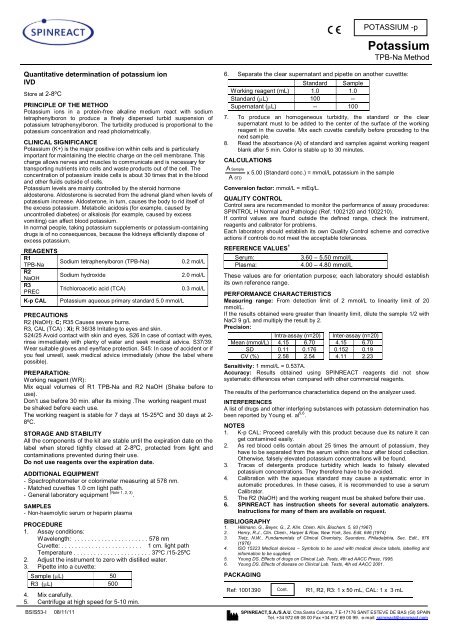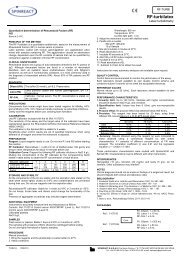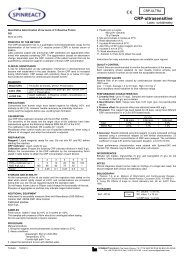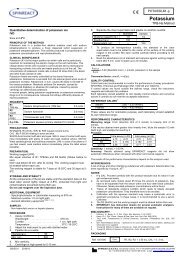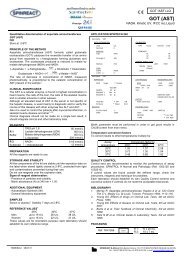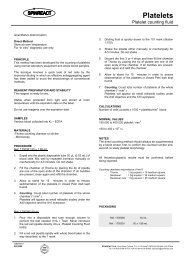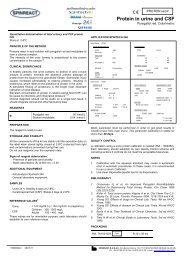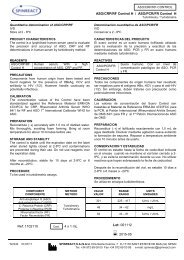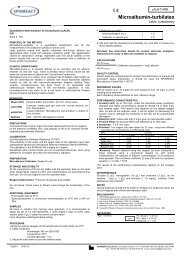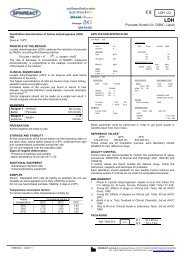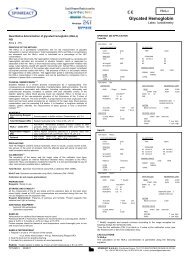Potassium
Potassium - Spinreact
Potassium - Spinreact
- No tags were found...
Create successful ePaper yourself
Turn your PDF publications into a flip-book with our unique Google optimized e-Paper software.
POTASSIUM -p<br />
<strong>Potassium</strong><br />
TPB-Na Method<br />
Quantitative determination of potassium ion<br />
IVD<br />
Store at 2-8ºC<br />
PRINCIPLE OF THE METHOD<br />
<strong>Potassium</strong> ions in a protein-free alkaline medium react with sodium<br />
tetraphenylboron to produce a finely dispersed turbid suspension of<br />
potassium tetraphenyylboron. The turbidity produced is proportional to the<br />
potassium concentration and read photometrically.<br />
CLINICAL SIGNIFICANCE<br />
<strong>Potassium</strong> (K+) is the major positive ion within cells and is particularly<br />
important for maintaining the electric charge on the cell membrane. This<br />
charge allows nerves and muscles to communicate and is necessary for<br />
transporting nutrients into cells and waste products out of the cell. The<br />
concentration of potassium inside cells is about 30 times that in the blood<br />
and other fluids outside of cells.<br />
<strong>Potassium</strong> levels are mainly controlled by the steroid hormone<br />
aldosterone. Aldosterone is secreted from the adrenal gland when levels of<br />
potassium increase. Aldosterone, in turn, causes the body to rid itself of<br />
the excess potassium. Metabolic acidosis (for example, caused by<br />
uncontrolled diabetes) or alkalosis (for example, caused by excess<br />
vomiting) can affect blood potassium.<br />
In normal people, taking potassium supplements or potassium-containing<br />
drugs is of no consequences, because the kidneys efficiently dispose of<br />
excess potassium.<br />
REAGENTS<br />
R1<br />
TPB-Na<br />
R2<br />
NaOH<br />
R3<br />
PREC<br />
K-p CAL<br />
Sodium tetraphenylboron (TPB-Na)<br />
Sodium hydroxide<br />
Trichloroacetic acid (TCA)<br />
<strong>Potassium</strong> aqueous primary standard 5.0 mmol/L<br />
0.2 mol/L<br />
2.0 mol/L<br />
0.3 mol/L<br />
PRECAUTIONS<br />
R2 (NaOH): C; R35 Causes severe burns.<br />
R3, CAL (TCA) : Xi; R 36/38 Irritating to eyes and skin.<br />
S24/25 Avoid contact with skin and eyes. S26 In case of contact with eyes,<br />
rinse immediately with plenty of water and seek medical advice. S37/39:<br />
Wear suitable gloves and eye/face protection. S45: In case of accident or if<br />
you feel unwell, seek medical advice immediately (show the label where<br />
possible).<br />
PREPARATION:<br />
Working reagent (WR):<br />
Mix equal volumes of R1 TPB-Na and R2 NaOH (Shake before to<br />
use).<br />
Don’t use before 30 min. after its mixing .The working reagent must<br />
be shaked before each use.<br />
The working reagent is stable for 7 days at 15-25ºC and 30 days at 2-<br />
8ºC.<br />
STORAGE AND STABILITY<br />
All the components of the kit are stable until the expiration date on the<br />
label when stored tightly closed at 2-8ºC, protected from light and<br />
contaminations prevented during their use.<br />
Do not use reagents over the expiration date.<br />
ADDITIONAL EQUIPMENT<br />
- Spectrophotometer or colorimeter measuring at 578 nm.<br />
- Matched cuvettes 1.0 cm light path.<br />
- General laboratory equipment (Note 1, 2, 3) .<br />
SAMPLES<br />
- Non-haemolytic serum or heparin plasma<br />
PROCEDURE<br />
1. Assay conditions:<br />
Wavelength: . . . . . . . . . . . . . . . . . . . . . . 578 nm<br />
Cuvette: . . . . . . . . . . . . . . . . . . . . . . . . 1 cm. light path<br />
Temperature . . . . . . . . . . . . . . . . . . . . . . . 37ºC /15-25ºC<br />
2. Adjust the instrument to zero with distilled water.<br />
3. Pipette into a cuvette:<br />
Sample ( L) 50<br />
R3 ( L) 500<br />
4. Mix carefully.<br />
5. Centrifuge at high speed for 5-10 min.<br />
6. Separate the clear supernatant and pipette on another cuvettte:<br />
Standard Sample<br />
Working reagent (mL) 1.0 1.0<br />
Standard ( L) 100 --<br />
Supernatant ( L) -- 100<br />
7. To produce an homogeneous turbidity, the standard or the clear<br />
supernatant must to be added to the center of the surface of the working<br />
reagent in the cuvette. Mix each cuvette carefully before proceding to the<br />
next sample.<br />
8. Read the absorbance (A) of standard and samples against working reagent<br />
blank after 5 min. Color is stable up to 30 minutes.<br />
CALCULATIONS<br />
A Sample<br />
x 5.00 (Standard conc.) = mmol/L potassium in the sample<br />
A STD<br />
Conversion factor: mmol/L = mEq/L.<br />
QUALITY CONTROL<br />
Control sera are recommended to monitor the performance of assay procedures:<br />
SPINTROL H Normal and Pathologic (Ref. 1002120 and 1002210).<br />
If control values are found outside the defined range, check the instrument,<br />
reagents and calibrator for problems.<br />
Each laboratory should establish its own Quality Control scheme and corrective<br />
actions if controls do not meet the acceptable tolerances.<br />
REFERENCE VALUES 1<br />
Serum:<br />
Plasma:<br />
3.60 – 5.50 mmol/L<br />
4.00 – 4.80 mmol/L<br />
These values are for orientation purpose; each laboratory should establish<br />
its own reference range.<br />
PERFORMANCE CHARACTERISTICS<br />
Measuring range: From detection limit of 2 mmol/L to linearity limit of 20<br />
mmol/L.<br />
If the results obtained were greater than linearity limit, dilute the sample 1/2 with<br />
NaCl 9 g/L and multiply the result by 2.<br />
Precision:<br />
Intra-assay (n=20) Inter-assay (n=20)<br />
Mean (mmol/L) 4.15 6.70 4.15 6.70<br />
SD 0.11 0.176 0.152 0.19<br />
CV (%) 2.58 2.54 4.11 2.23<br />
Sensitivity: 1 mmol/L = 0.537A.<br />
Accuracy: Results obtained using SPINREACT reagents did not show<br />
systematic differences when compared with other commercial reagents.<br />
The results of the performance characteristics depend on the analyzer used.<br />
INTERFERENCES<br />
A list of drugs and other interfering substances with potassium determination has<br />
been reported by Young et. al 5,6 .<br />
NOTES<br />
1. K-p CAL: Proceed carefully with this product because due its nature it can<br />
get contamined easily.<br />
2. As red blood cells contain about 25 times the amount of potassium, they<br />
have to be separated from the serum within one hour after blood collection.<br />
Otherwise, falsely elevated potassium concentrations will be found.<br />
3. Traces of detergents produce turbidity which leads to falsely elevated<br />
potassium concentrations. They therefore have to be avoided.<br />
4. Calibration with the aqueous standard may cause a systematic error in<br />
automatic procedures. In these cases, it is recommended to use a serum<br />
Calibrator.<br />
5. The R2 (NaOH) and the working reagent must be shaked before their use.<br />
6. SPINREACT has instruction sheets for several automatic analyzers.<br />
Instructions for many of them are available on request.<br />
BIBLIOGRAPHY<br />
1. Hillmann, G., Beyer, G., Z. Klin. Chem. Klin. Biochem. 5, 93 (1967)<br />
2. Henry, R.J., Clin. Chem., Harper & Row, New York, Sec. Edit. 646 (1974)<br />
3. Tietz, N.W., Fundamentals of Clinical Chemistry, Saunders, Philadelphia, Sec. Edit., 876<br />
(1976)<br />
4. ISO 15223 Medical devices – Symbols to be used with medical device labels, labelling and<br />
information to be supplied.<br />
5. Young DS. Effects of drugs on Clinical Lab. Tests, 4th ed AACC Press, 1995.<br />
6. Young DS. Effects of disease on Clinical Lab. Tests, 4th ed AACC 2001.<br />
PACKAGING<br />
Ref: 1001390<br />
Cont.<br />
R1, R2, R3: 1 x 50 mL, CAL: 1 x 3 mL<br />
BSIS53-I 08/11/11 SPINREACT,S.A./S.A.U. Ctra.Santa Coloma, 7 E-17176 SANT ESTEVE DE BAS (GI) SPAIN<br />
Tel. +34 972 69 08 00 Fax +34 972 69 00 99. e-mail: spinreact@spinreact.com
POTASSIUM -p<br />
Potasio<br />
Método TPB-Na<br />
Determinación cuantitativa de potasio<br />
IVD<br />
Conservar a 2-8ºC<br />
PRINCIPIO DEL MÉTODO<br />
El potasio reacciona con el tetrafenilborato sódico en un medio alcalino<br />
libre de proteínas formándose una turbidez dispersa de tetrafenilborato de<br />
potasio. La turbidez producida es proporcional a la concentración de<br />
potasio y puede medirse fotométricamente.<br />
SIGNIFICADO CLÍNICO<br />
Este test se realiza cuando hay síntomas de la presencia de un<br />
desequilibrio en los niveles de potasio, o cuando se aprecian desordenes<br />
provocados por valores anormales de potasio.<br />
El potasio (K + ) es uno de los iones mayoritarios en los fluidos externos de<br />
las células y resulta especialmente importante para mantener la carga<br />
eléctrica de las membranas celulares. Esta carga permite la comunicación<br />
de nervios y músculos. La concentración de potasio dentro de las células<br />
es aproximadamente 30 veces superior a la de la sangre y otros fluidos<br />
extracelulares. Los niveles de potasio están controlados por la hormona<br />
aldosterona. Esta hormona es segregada por la glándula adrenal cuando<br />
los niveles de potasio aumentan. La acidosis metabólica (causada por una<br />
diabetes incontrolada) o la alcalosis (causad por vómitos excesivos)<br />
pueden modificar el potasio en sangre.<br />
REACTIVOS<br />
R1<br />
TPB-Na<br />
Tetrafenilborato de sodio (TPB-Na)<br />
R2<br />
NaOH<br />
Hidróxido sódico<br />
R3<br />
PREC<br />
Acido tricloroacético (TCA)<br />
K-p CAL<br />
Patrón primario acuoso de Potasio 5.00 mmol/L<br />
0.2 mol/L<br />
2.0 mol/L<br />
0.3 mol/L<br />
PRECAUCIONES<br />
R2 NAOH: C; R35 Provoca quemaduras graves.<br />
R3, CAL (TCA): Xi; R36/38 Irrita los ojos y la piel.<br />
S24/25 Evítese el contacto con los ojos y la piel. S26 En caso de contacto<br />
con los ojos, lávense inmediata y abundantemente con agua y acúdase a<br />
un médico. S37/39 Úsense guantes adecuados y protección para los<br />
ojos/la cara. S45 En caso de accidente o malestar, acúdase<br />
inmediatamente al médico (si es posible, muéstresele la etiqueta).<br />
PREPARACIÓN<br />
Reactivo de trabajo (RT):<br />
Mezclar volúmenes iguales de R1 TPB-Na y R2 NaOH (Agitar antes de<br />
usar).<br />
No utilizar antes de 30 min. después de su mezcla. Agitar el reactivo de<br />
trabajo antes de cada uso.<br />
Estabilidad del reactivo de trabajo: 7 días a 15-25ºC o 30 días a 2-8ºC.<br />
CONSERVACIÓN Y ESTABILIDAD<br />
Todos los componentes del kit son estables, hasta la fecha de caducidad<br />
indicada en la etiqueta, cuando se mantienen los frascos bien cerrados a<br />
2-8ºC, protegidos de la luz y se evita su contaminación. No usar<br />
reactivos fuera de la fecha indicada.<br />
MATERIAL ADICIONAL<br />
- Espectrofotómetro o analizador con cubeta para lecturas a 578 nm.<br />
- Cubetas de 1,0 cm. de paso de luz.<br />
- Equipamiento habitual de laboratorio (Nota 1, 2, 3) .<br />
MUESTRAS<br />
- Suero no hemolizado o plasma heparinizado.<br />
PROCEDIMIENTO<br />
1. Condiciones del ensayo:<br />
Longitud de onda: . . . . . . . . . . . . . . . . . . . . . . . . . . . 578 nm<br />
Cubeta:. . . . . . . . . . . . . . . . . . . . . . . . . . . . .1 cm paso de luz<br />
Temperatura . . . . . . . . . . . . . . . . . . . . . . . . . . 37ºC /15-25ºC<br />
2. Ajustar el espectrofotómetro a cero frente a agua destilada.<br />
3. Pipetear en una cubeta:<br />
Muestra ( L) 50<br />
R3 ( L) 500<br />
4. Agitar cuidadosamente.<br />
5. Centrifugar a alta velocidad durante 5-10 min.<br />
6. Separar el sobrenadante y pipetear en una cubeta:<br />
Patrón Muestra<br />
React. Trabajo (mL) 1.0 1.0<br />
Standard ( L) 100 --<br />
Sobrenadante ( L) -- 100<br />
7. Para producir una turbidez homogénea, el Standard y el sobrenadante<br />
deben dosificarse en el centro del reactivo de trabajo. Mezclar<br />
homogéneamente antes de proceder con la siguiente muestra.<br />
8. Leer la absorbancia (A) del standard y de las muestras frente al blanco de<br />
reactivo después de 5 minutos. El color es estable 30 minutos.<br />
CÁLCULOS<br />
A Muestra<br />
x 5.00 (Conc. Patrón) = mmol/L de iones potasio<br />
A STD<br />
Factor de conversión: mmol/L= mEq/L.<br />
CONTROL DE CALIDAD<br />
Es conveniente analizar junto con las muestras sueros control valorados:<br />
SPINTROL H Normal y Patológico (Ref. 1002120 y 1002210).<br />
Si los valores hallados se encuentran fuera del rango de tolerancia, revisar el<br />
instrumento, los reactivos y el calibrador.<br />
Cada laboratorio debe disponer su propio Control de Calidad y establecer<br />
correcciones en el caso de que los controles no cumplan con las tolerancias.<br />
VALORES DE REFERENCIA 1<br />
Suero:<br />
Plasma:<br />
3.60 – 5.50 mmol/L<br />
4.00 – 4.80 mmol/L<br />
Estos valores son orientativos. Es recomendable que cada laboratorio<br />
establezca sus propios valores de referencia.<br />
CARACTERÍSTICAS DEL MÉTODO<br />
Rango de medida: Desde el límite de detección de 2 mmol/L hasta el límite de<br />
linealidad de 20 mmol/L.<br />
Si la concentración de la muestra es superior al límite de linealidad, diluir 1/2 con<br />
ClNa 9 g/L y multiplicar el resultado final por 2.<br />
Precisión:<br />
Intraserie (n=20) Interserie (n=20)<br />
Media (mmol/L) 4.15 6.70 4.15 6.70<br />
SD 0.11 0.176 0.152 0.19<br />
CV (%) 2.58 2.54 4.11 2.23<br />
Sensibilidad analítica: 1 mmol/L = 0,537 A.<br />
Exactitud: Los reactivos SPINREACT no muestran diferencias sistemáticas<br />
significativas cuando se comparan con otros reactivos comerciales.<br />
Las características del método pueden variar según el analizador utilizado.<br />
INTERFERENCIAS<br />
Se han descrito varias drogas y otras substancias que interfieren con la<br />
determinación del potasio 5,6 .<br />
NOTAS<br />
1. K-p CAL: Debido a la naturaleza del producto, es aconsejable tratarlo con<br />
sumo cuidado ya que se puede contaminar con facilidad.<br />
2. Debido a que los hematíes contienen 25 veces más de potasio, deben<br />
separarse del suero dentro de la hora siguiente tras la toma de muestra.<br />
De lo contrario se obtendrán falsos resultados elevados.<br />
3. Restos de detergente producen turbidez que resultara falsos resultados<br />
positivos. Se recomienda utilizar material de plástico de un solo uso para<br />
evitar contaminaciones.<br />
4. La calibración con el Patrón acuoso puede dar lugar a errores<br />
sistemáticos en métodos automáticos. En este caso, se recomienda<br />
utilizar calibradores séricos.<br />
5. El R2 (NaOH) y el reactivo de trabajo se deben agitar antes de usar.<br />
6. SPINREACT dispone de instrucciones detalladas para la aplicación<br />
de este reactivo en distintos analizadores.<br />
BIBLIOGRAFÍA<br />
1. Hillmann, G., Beyer, G., Z. Klin. Chem. Klin. Biochem. 5, 93 (1967)<br />
2. Henry, R.J., Clin. Chem., Harper & Row, New York, Sec. Edit. 646 (1974)<br />
3. Tietz, N.W., Fundamentals of Clinical Chemistry, Saunders, Philadelphia, Sec. Edit., 876<br />
(1976)<br />
4. ISO 15223 Medical devices – Symbols to be used with medical device labels, labelling and<br />
information to be supplied.<br />
5. Young DS. Effects of drugs on Clinical Lab. Tests, 4th ed AACC Press, 1995.<br />
6. Young DS. Effects of disease on Clinical Lab. Tests, 4th ed AACC 2001.<br />
PRESENTACIÓN<br />
Ref: 1001390<br />
Cont.<br />
R1, R2, R3: 1 x 50 mL, CAL: 1 x 3 mL<br />
BSIS53-E 08/11/11 SPINREACT,S.A./S.A.U. Ctra.Santa Coloma, 7 E-17176 SANT ESTEVE DE BAS (GI) SPAIN<br />
Tel. +34 972 69 08 00 Fax +34 972 69 00 99. e-mail: spinreact@spinreact.com


